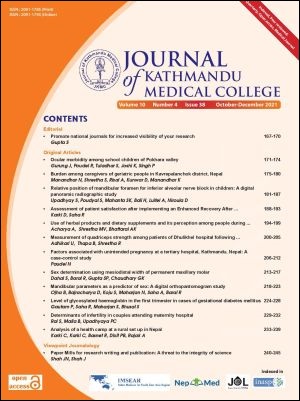Relative position of mandibular foramen for inferior alveolar nerve block in children: A digital panoramic radiographic study
DOI:
https://doi.org/10.3126/jkmc.v10i4.43858Keywords:
Inferior alveolar nerve block, Mandibular foramen, Occlusal plane, Panoramic radiographAbstract
Background: For a successful inferior alveolar nerve block, good knowledge of position of mandibular foramen is imperative.
Objectives: To evaluate the position of mandibular foramen in relation to mandibular occlusal plane and anterior border of ramus in a selected population of children in Nepal using digital panoramic radiographs.
Methods: An analytical cross-sectional study was done after ethical approval in convenient sample of 180 children of 3-13 years in department of Paediatric and Preventive Dentistry, Dhulikhel Hospital from January 2021 to August 2021. Their digital panoramic radiographs were analysed using software Rainbow TM Image Viewer version 1.0.0.0. Mean with standard deviation were calculated for linear measurements taken from mandibular foramen to mandibular occlusal plane and deepest point on the anterior border of ramus. Paired t-test was used to compare measurements between right and left sides. Student t-test was used to evaluate the difference between boys and girls. Pearson correlation was used to observe the correlation of age with the linear measurements.
Results: The mean linear measurements increased along with the increase in age (p <0.05). There was statistically significant difference in linear measurements between the two sides of mandible except in 3-4 years children for mandibular foramen to anterior border of ramus which was not significant (p = 0.090). There was no significant difference in linear measurements between boys and girls.
Conclusion: For inferior alveolar nerve block, the needle should be placed below the occlusal plane in children up to seven years of age and above for higher ages.
Downloads
Downloads
Published
How to Cite
Issue
Section
License
Copyright © Journal of Kathmandu Medical College
The ideas and opinions expressed by authors or articles summarized, quoted, or published in full text in this journal represent only the opinions of the authors and do not necessarily reflect the official policy of Journal of Kathmandu Medical College or the institute with which the author(s) is/are affiliated, unless so specified.
Authors convey all copyright ownership, including any and all rights incidental thereto, exclusively to JKMC, in the event that such work is published by JKMC. JKMC shall own the work, including 1) copyright; 2) the right to grant permission to republish the article in whole or in part, with or without fee; 3) the right to produce preprints or reprints and translate into languages other than English for sale or free distribution; and 4) the right to republish the work in a collection of articles in any other mechanical or electronic format.




